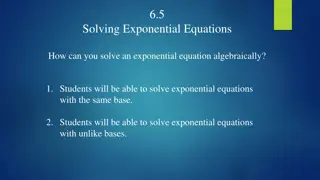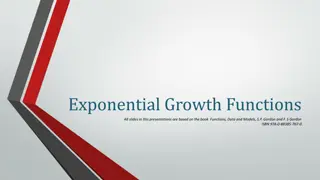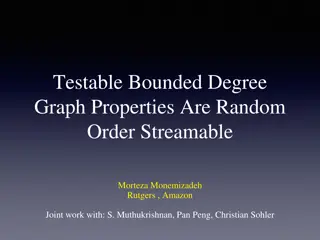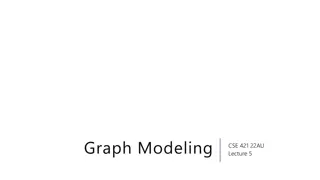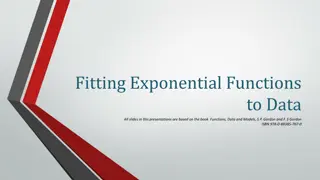Understanding Exponential Random Graph Models (ERGMs) in Social Network Analysis
Exponential Random Graph Models (ERGMs) play a crucial role in predicting network ties in social networks by accounting for network dependence and incorporating both exogenous and endogenous variables. These models allow for testing multiple theories and competitive explanations for network formation. The lecture draws heavily on the work of experts in the field to provide a comprehensive understanding of ERGMs and their applications.
Download Presentation

Please find below an Image/Link to download the presentation.
The content on the website is provided AS IS for your information and personal use only. It may not be sold, licensed, or shared on other websites without obtaining consent from the author. Download presentation by click this link. If you encounter any issues during the download, it is possible that the publisher has removed the file from their server.
E N D
Presentation Transcript
Network Analysis Statistical Analysis of Social Network Data MICHAEL T. HEANEY UNIVERSITY OF GLASGOW JUNE 14, 2023 LECTURE 06
Exponential Random Graph Models (ERGMs) This lecture draws heavily on: Dean Lusher, Johan Koskinen, and Garry Robins. 2013. Exponential Random Graph Models for Social Networks: Theory, Methods, and Applications. New York: Cambridge University Press. Skyler J. Cranmer, Bruce A. Desmarais, and Jason W. Morgan. 2021. Inferential Network Analysis. New York: Cambridge University Press.
Purpose The goal of an ERGM is to predict the presence or absence of a network tie between every dyad in a network.
Purpose The goal of an ERGM is to predict the presence or absence of a network tie between every dyad in a network. By understanding the formation of dyads while explicitly accounting for network dependence, we understand the formation of network structures.
Purpose The goal of an ERGM is to predict the presence or absence of a network tie between every dyad in a network. By understanding the formation of dyads while explicitly accounting for network dependence, we understand the formation of network structures. The presence of both exogenous and endogenous explanatory variables allows us to test competing explanations for network formation.
What kind of theory behind ERGMs? There is not a single theory behind ERGMs in that they allow for the competitive test of multiple theories.
What kind of theory behind ERGMs? There is not a single theory behind ERGMs in that they allow for the competitive test of multiple theories. (Just as there is no single theory behind regression.)
What kind of theory behind ERGMs? There is not a single theory behind ERGMs in that they allow for the competitive test of multiple theories. (Just as there is no single theory behind regression.) Yet there is a network meta theory or framework that underlies ERGMs.
What kind of theory behind ERGMs? There is not a single theory behind ERGMs in that they allow for the competitive test of multiple theories. (Just as there is no single theory behind regression.) Yet there is a network meta theory or framework that underlies ERGMs. (Just as there is a meta theory behind regression which relates to independent social action.)
The Meta Theory behind ERGMs Social networks are locally emergent (e.g., preferential attachment)
The Meta Theory behind ERGMs Social networks are locally emergent (e.g., preferential attachment) Tie formation depends both on the formation of other ties (i.e., network dependence) and on attributes of actors, ties, and other exogenous factors.
The Meta Theory behind ERGMs Social networks are locally emergent (e.g., preferential attachment) Tie formation depends both on the formation of other ties (i.e., network dependence) and on attributes of actors, ties, and other exogenous factors. Patterns in networks are part of ongoing social processes.
The Meta Theory behind ERGMs Social networks are locally emergent (e.g., preferential attachment) Tie formation depends both on the formation of other ties (i.e., network dependence) and on attributes of actors, ties, and other exogenous factors. Patterns in networks are part of ongoing social processes. Multiple processes can operate simultaneously (e.g., homophily and triadic closure).
The Meta Theory behind ERGMs Social networks are locally emergent (e.g., preferential attachment) Tie formation depends both on the formation of other ties (i.e., network dependence) and on attributes of actors, ties, and other exogenous factors. Patterns in networks are part of ongoing social processes. Multiple processes can operate simultaneously (e.g., homophily and triadic closure). Networks are both structured and stochastic.
Network Configurations A network configuration is a possible subgraph that may represent a local regularity in a social network structure.
Some Common Network Configurations Reciprocity Two-path Transitive closure Activity / Out two-star Arc / Density Popularity / in two-star Homophily Heterophily
Some Configurations in Multiplex Networks Co-occurrence A B Entrainment A B Reciprocity B A
Some Configurations in Two-Mode Networks 2 B1 Stars 2 1 2 2 B2 Stars 1 2 1 Four Cycle 2 1 1 2
Types of Network Dependence Bernoulli Independence (ties are independent)
Types of Network Dependence Bernoulli Independence (ties are independent) Dyadic Dependence (e.g., reciprocity)
Types of Network Dependence Bernoulli Independence (ties are independent) Dyadic Dependence (e.g., reciprocity) Markov Dependence Nodes are dependent if they share a tie.
Types of Network Dependence Bernoulli Independence (ties are independent) Dyadic Dependence (e.g., reciprocity) Markov Dependence Nodes are dependent if they share a tie. Social Circuit Dependence (e.g., 4-cycles)
Types of Network Dependence Bernoulli Independence (ties are independent) Dyadic Dependence (e.g., reciprocity) Markov Dependence Nodes are dependent if they share a tie. Social Circuit Dependence (e.g., 4-cycles) Higher-order dependence (e.g., geometrically weighted dependence)
The Problem of Network Statistics We observe one instantiation of a network, but there are many possible instantiation of a network.
The Problem of Network Statistics We observe one instantiation of a network, but there are many possible instantiation of a network. In a directed graph, there are 2n(n-1) possible instantiations of the network, which is a VERY large number.
The Problem of Network Statistics We observe one instantiation of a network, but there are many possible instantiation of a network. In a directed graph, there are 2n(n-1) possible instantiations of the network, which is a VERY large number. Since it is generally beyond our computing capacity to consider all possible graphs, we take a sample random graphs (our sample space ), which provides a baseline distribution for our analysis.
The Statistical Task of an ERGM ERGM tries to find a distribution of random graphs that, on average, have similar properties to our observed network in terms of nodes, links, reciprocity, transitivity, etc.
The Statistical Task of an ERGM ERGM tries to find a distribution of random graphs that, on average, have similar properties to our observed network in terms of nodes, links, reciprocity, transitivity, etc. ERGM tries to find estimates such that simulations from the network are not extremely different from our observed network.
Logistic Regression Pr ???= 1 ?) ???{?1 ???,1+?2 ???,1+...+?? ???,?} 1+ exp{?1 ???,1+?2 ???,1+...+?? ???,?} logPr ???=1 ?) Pr ???=0 ?) = = ?0+ ?1???,1+ ?2???,2+ +?????,?
Departures from Logistic Regression We usually want to add endogenous covariates in addition to exogenous covariates. In fact, we do not have an ERGM unless we have endogenous covariates.
Departures from Logistic Regression We usually want to add endogenous covariates in addition to exogenous covariates. In fact, we do not have an ERGM unless we have endogenous covariates. Each tie is conditional on the rest of the graph.
Departures from Logistic Regression We usually want to add endogenous covariates in addition to exogenous covariates. In fact, we do not have an ERGM unless we have endogenous covariates. Each tie is conditional on the rest of the graph. Change statistics incorporate the effect of any individual tie switching from 0 to 1 or vice versa.
Departures from Logistic Regression We usually want to add endogenous covariates in addition to exogenous covariates. In fact, we do not have an ERGM unless we have endogenous covariates. Each tie is conditional on the rest of the graph. Change statistics incorporate the effect of any individual tie switching from 0 to 1 or vice versa. There is no single ERGM there is a different ERGM for each dependence assumption.
Departures from Logistic Regression We usually want to add endogenous covariates in addition to exogenous covariates. In fact, we do not have an ERGM unless we have endogenous covariates. Each tie is conditional on the rest of the graph. Change statistics incorporate the effect of any individual tie switching from 0 to 1 or vice versa. There is no single ERGM there is a different ERGM for each dependence assumption. The technically correct terminology is exponential- family random graph model but family is traditionally dropped.
Exponential-Family Random Graph Models Pr ???= 1 ?) = ???{? ? } ? ?exp{? ? } h(X): Network statistics : Effects ???{? ? }: Weight ? ????{? ? }: Normalizer based on possible permutations of the network.
Specifying h(X) Reciprocity Transitivity Geometrically weighted or curved models. h(X) may consist of these and / or other configurations.
One-Mode versus Two-Mode ERGMs ERGMs can be estimated on either one-model or two-mode networks. Two adjustments are needed to fit a two-mode network. In a two-model network, the X needs to be restricted to possible values only i.e., structural zeros. Two-mode networks have a different h(X) structure, such using B1 Star and B2 Star variables.
Count ERGMs Binary ERGMs can readily be extended to address variation in the strength of ties by using count ERGMs. A common approach to use a Poisson distribution as the reference distribution. For details, see the work of Pavel Krivitsky, such as https://cran.r-project.org/web/packages/ergm.count/ergm.count.pdf Generalized Exponential Random Graph Models (GERGMs) can also tackle counts but they further accommodate continuous variables and, thus, represent a more substantial departure from the binary ERGM framework.
Estimating ERGMs There are different methods of estimating ERGMs.
Estimating ERGMs There are different methods of estimating ERGMs. Markov Chain Monte Carlo (MCMC) estimation is the most common method.
Estimating ERGMs There are different methods of estimating ERGMs. Markov Chain Monte Carlo (MCMC) estimation is the most common method. MCMC is an approximation of Maximum Likelihood Estimation, which is generally infeasible in large networks. Approximates MLE in large samples.
Estimating ERGMs There are different methods of estimating ERGMs. Markov Chain Monte Carlo (MCMC) estimation is the most common method. MCMC is an approximation of Maximum Likelihood Estimation, which is generally infeasible in large networks. Approximates MLE in large samples. Proceeds by making one change to a network (substituting a 0 for a 1, vice versa) repeated many times to generate a vector of change statistics (h(X)), which is used to estimate the ERGM.
Estimating ERGMs There are different methods of estimating ERGMs. Markov Chain Monte Carlo (MCMC) estimation is the most common method. MCMC is an approximation of Maximum Likelihood Estimation, which is generally infeasible in large networks. Approximates MLE in large samples. Proceeds by making one change to a network (substituting a 0 for a 1, vice versa) repeated many times to generate a vector of change statistics (h(X)), which is used to estimate the ERGM. Degeneracy is a common problem because of the large number of possible permutations of the network leads to large jumps in the network s density.











